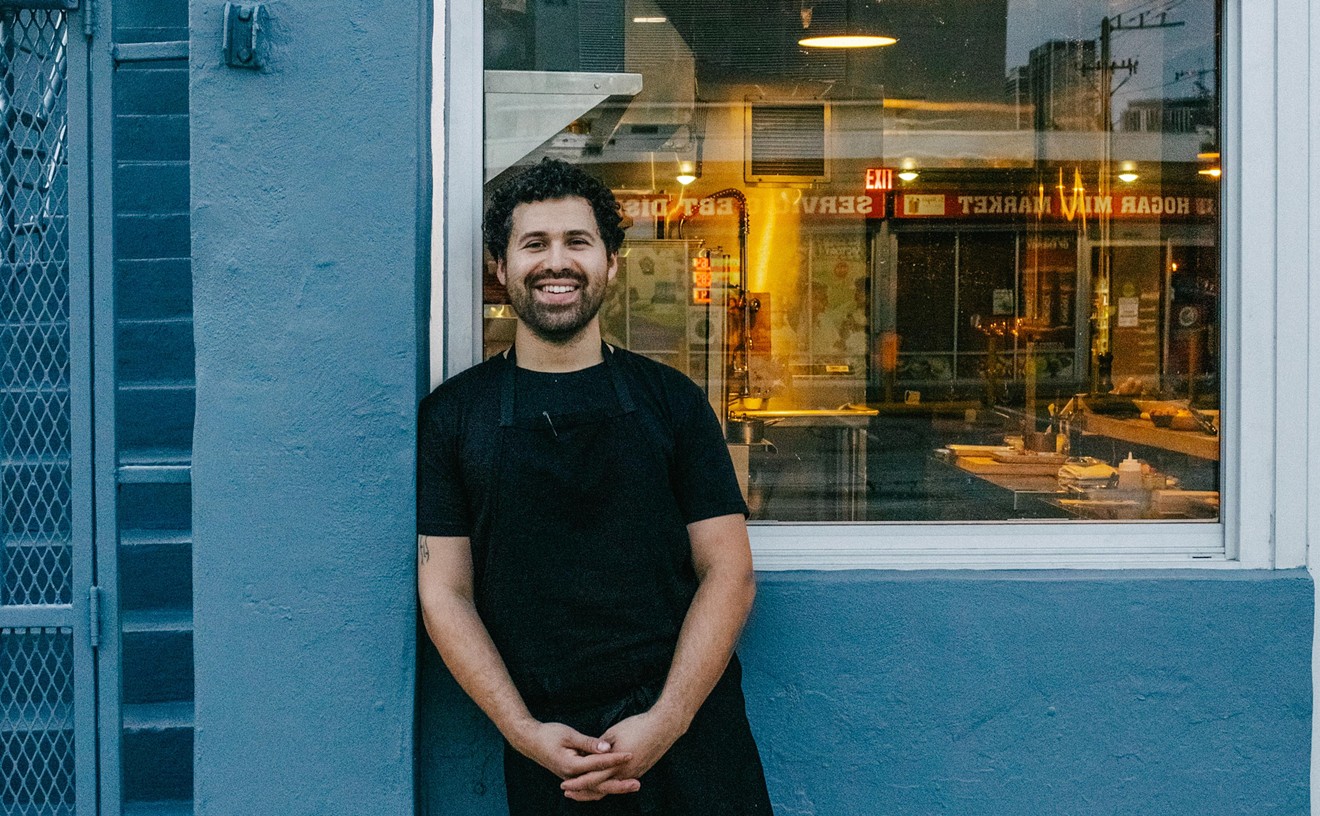Blade looks pretty sharp, especially for a dark, windowless room with a low ceiling. Multiple industrial textures (raw wood, stone, concrete, glass) and sexy lighting lend the subterranean space a sleek, lounge-like appeal, even if it's reminiscent of a slots-less casino. A bar that winds across the room features three sushi stations and a whole lotta shakin' of cocktails. The clientele is primped and primed for a good time while music pulsates above the considerable buzz. This isn't a place to take your visiting Aunt Nellie. It probably isn't the best restaurant to take anyone serious about food either.
It is, however, a great spot for sipping sake. There are three tiers of quality — the top-flight spirits including fresh-from-the-vat Masumi Arabashiri and a 5-year-old Dewazakura Yukimanman perfumed with persimmon and pomegranate. Blade is well suited for any type of alcoholic imbibing; it also boasts extensive beer and wine selections along with a truly delectable array of mixologist-concocted cocktails, silly saketinis, and everything in between. The sangria, made with plum wine, Merlot, premium sake, citrus juices, Asian pears, and Granny Smith apples, is so delicious it's worth bellying up to the bar and squeezing between two loud, vacuous people in order to get one.
A bowl of edamame is brought to each table for diners to munch while perusing menu choices and regaining their eyesight. The latter act is necessitated by a blinding light the menu emits upon opening; once your eyes become accustomed to the illumination, however, it really does prove effective for reading in the dark. Will we be seeing more interactive iPad-style menus in the near future? No doubt.
Blade's menu might be the brightest in town, but the content has gotten much duller since the restaurant opened. Sushi selections used to be wider, maki rolls were more distinctive, and appetizers and entrées engaged to a far greater degree. Sushi choices still net most fish or shellfish you're accustomed to seeing wrapped in nori, but you won't catch anything cutting-edge or, for that matter, any dish not unavailable at Iron Sushi. For instance, you would be hard-pressed to distinguish among five "regular roll" makis (which include salmon with avocado and cucumber, and tuna with cucumber) and the half-dozen "Blade special" rolls (such as tempura shrimp with avocado and cucumber, and spicy tuna with scallion). Take a guess: Would a California roll be characterized as "regular" or "special"? Sorry, you're wrong; here it's considered "special." A soft-shell crab roll was similarly labeled but proved to be a crunchy mangle of battered, meatless soft shells, avocado, and romaine lettuce, with orange masago (capelin roe) on top.
On the other hand, nigiri/sashimi items were superfresh and adeptly prepared. A preselected sashimi trio ($22 or five for $32) brought a melting pair each of tuna, yellowtail, and thinly sliced salmon striped with buttery fat. Rice grains beneath were distinct and fully flavored — if a tad spicy with wasabi. Nigiri servings of fluke and sweetly glazed freshwater eel likewise brought nods of approval.
Nonsushi items from chef de cuisine Kasajima Shigeru's menu include a few soups and salads; a pot sticker, chicken yakitori, and tempura variations; and a dozen "signature" appetizers and entrées. Thai beef salad with papaya, red onion, lime juice, and cilantro sounded like a refreshing start, and it was — even if the papaya was missing. In its place were jicama, tomato, and chopped peanuts, which seemed a satisfactory trade-off, but it is incumbent upon the waiter to note such substitutions. Unfortunately, while servers here bring the food in a polite and competent manner, their abilities — or training — go only so deep.
Best of the signatures, and indeed the singular wow moment of our meals, came in the form of a single, enormous, succulently seared sea scallop in spicy, sake-spiked calabaza broth. My idea of a happy meal would be two or three of these beefy bivalves (at $9 each, the least expensive hot plate), a glass of smooth sake, and some slices of baguette to sop up the scrumptious sauce — eminently doable if you bring a baguette.
Also good were Oriental barbecue spare ribs: a generous, meaty rack glazed with honey and spice. "Crispy tuna eggplant with unagi sauce" brought a lineup of five fried, canape-size eggplant slices, each capped with a dab of tuna tartare and pooled in a bit of eel sauce. Problem was that the fried eggplant flavor flattened the delicate tartare notes. Skip this one.
Only the snapper and sirloin dishes cost more than $18, the former bringing a fried fillet painted with dark, sweet soya glaze and sautéed leeks. The most bountiful plate, and one of the most flavorful, hosted three bulky, boneless, spicily curried chicken thighs with a dish of mango relish for cooling and a side of jasmine rice assertively scented with star anise.
Blade's price per item isn't high, but any combination of drinks, sushi, and appetizers will end up taking a not-insignificant slice of your paycheck. Add a ten-spot for any of the three desserts: chocolate fondant, mochi ice creams, and a quintet of dense, sweet, chocolate-covered cheesecake lollipops with a trio of sweeter dipping sauces (chocolate, strawberry, and dulce de leche). Like so much about Blade, the cheesecake pops look pretty — but when you cut through the glitz, they are really nothing special.










